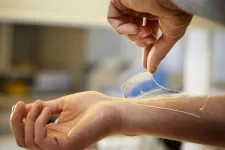(Press-News.org) Scientists at the Centro Nacional de Investigaciones Cardiovasculares Centro de Biología Molecular Severo Ochoa (CBM-CSIC-UAM) have discovered that the nitric oxide (NO) pathway is overactivated in the aortas of mice and patients with Marfan Syndrome and that the activity of this pathway causes the aortic aneurysms that characterize this disease.
The results of the study, published today in Nature Communications, reveal the essential role played by NO in Marfan Syndrome aortic disease and identify new therapeutic targets and markers of NO pathway activation that could be used to monitor disease status and progression.
Aortic aneurysm (AA) is a progressive dilatation and weakening of the aortic wall. AA can be harmless, but in some patients can lead to dissection (rupture) of the aorta, resulting in death.
Marfan Syndrome is a hereditary disease that affects connective tissues, which are the fibrous structures that bind and anchor all the organs and tissues in the body. Marfan Syndrome principally affects the skeleton, the eyes, the heart, and the blood vessels. A particularly common disease manifestation is thoracic aortic aneurysm and dissection (TAAD). "Aortic dissection accounts for more than 90% of deaths associated with Marfan Syndrome," explained CNIC investigator Dr. Juan Miguel Redondo, study co-director together with CBM-CSIC-UAM investigator Dr. Miguel Campanero.
Current treatments for Marfan Syndrome are aimed at reducing blood pressure on the artery wall, but do not prevent its deterioration. The only effective intervention for the aortic disease in Marfan Syndrom is surgery.
The researchers therefore recognize "the urgent need to identify new targets for the development of pharmacological treatments for TAAD in Marfan Syndrome."
The study, whose first authors are Andrea de la Fuente-Alonso and Marta Toral, reveals the essential role played by NO in Marfan Syndrome aortic disease. "We previously detected high expression of a protein with a high capacity for NO production in the aortas of Marfan Syndrome patients and an animal model of the disease, and we therefore undertook an in depth investigation of the role of NO in the associated aortic disease," explained Dr. Campanero.
"We observed that treatment of healthy mice with supra-pharmacological doses of an NO donor induced TAAD similar to that seen in Marfan mice. The NO donor treatment also reproduced the degeneration of the aortic wall, an essential step in the development of TAAD," added Dr. Redondo. "Through these experiments, we showed that elevated production of NO is necessary and sufficient for the development of TAAD in Marfan Syndrome."
Given this important role of NO in the development of TAAD, the researchers decided to focus on the enzymes soluble guanylate cyclase (sGC) and type I cGMP-dependent protein kinase (PRKG1), two NO-regulated proteins. "Our analysis detected elevated activities of both sGC and PRKG1 in samples from mice and patients with Marfan Syndrome," said Dr. Redondo.
"We were able to completely reverse the aortic disease in Marfan mice by treating them with inhibitors of these two proteins or by genetically silencing the expression of Prkg1, demonstrating that the NO-sGC-PRKG1 pathway mediates the development of TAAD in Marfan Syndrome," added Dr. Campanero.
Given the need for new pharmacological treatments for Mafan Syndrome aortic disease, "the results of this study open the way to the use of sGC and PRKG1 inhibitors in preclinical and clinical trials for this syndrome and possibly other aortic diseases," said Dr. Redondo.
The research team also explored possible "footprints" left by high NO levels in the blood. "Working with the CNIC Proteomics Unit and clinical groups at Vall D´Hebron, Puerta de Hierro, Marqués de Valdecilla, and Ghent University hospitals, we found that the high NO levels in Marfan Syndrome lead to increases in protein nitration and cGMP in the blood of mice and patients with this disease," said Dr. Campanero.
"This discovery has important implications for patients with this syndrome, because these molecules could be used as biomarkers for disease monitoring, and we are now studying their potential as prognostic indicators," explained Dr. Redondo.
The researcher conclude that their results are therefore "good news."
INFORMATION:
The study was funding by the Fundación "la Caixa" through the CaixaResearch Call for Health Projects with 500.000 euros, the Ministerio de Ciencia, Investigación y Universidades, the Community of Madrid regional government, the CSIC, the Pro CNIC Foundation, the Marfan Foundation, the Fundación La Marató, and the Instituto de Salud Carlos III CIBER cardiovascular (CIBER-CV).
* de la Fuente-Alonso, A; Toral, M; Álvaro-Alfayate, A; Ruiz-Rodríguez, M.J; Bonzon-Kulichenko, E; Teixido-Tura, G; ...; Campanero, M.R; and Redondo, J.M. (2021). Aortic disease in Marfan syndrome is caused by overactivation of sGC-PRKG signaling by NO. Nature communication. doi: 10.1038/s41467-021-22933-3
About the CNIC
The Centro Nacional de Investigaciones Cardiovasculares (CNIC), directed by Dr. Valentín Fuster, is dedicated to cardiovascular research and the translation of knowledge gained into real benefits for patients. The CNIC, recognized by the Spanish government as a Severo Ochoa center of excellence, is financed through a pioneering public-private partnership between the government (through the Carlos III Institute of Health) and the Pro-CNIC Foundation, which brings together 12 of the most important Spanish private companies.
A new paper in the Journal of the European Economic Association, published by Oxford University Press, indicates that distrust generated by a 2011 CIA-led vaccination campaign ruse designed to catch Osama Bin Laden resulted in a significant vaccination rate decline in Pakistan.
Using a local doctor, the US Central Intelligence Organization planned an immunization plan in Pakistan to obtain DNA samples of children living in a compound in Abbottabad where American authorities suspected Bin Laden was hiding in order to obtain proof of Bin Laden's location (because the presence of close ...
About 42% of rural school districts in the U.S. offered fully in-person instruction as of February, compared with only 17% for urban districts, according to a new RAND Corporation survey of school district leaders. The opposite pattern held for fully remote learning: 29% of urban districts offered fully remote instruction compared with 10% of rural districts and 18% of suburban districts.
The choice of in-person versus remote learning has important implications. Over a third of all U.S. school districts offering some form of remote instruction in early 2021 had shortened the school day, and a quarter had reduced instructional minutes.
"This survey shows how the choice of remote instruction has ramifications that extend beyond longstanding concerns about ...
Aqueducts are very impressive examples of the art of construction in the Roman Empire. Even today, they still provide us with new insights into aesthetic, practical, and technical aspects of construction and use. Scientists at Johannes Gutenberg University Mainz (JGU) investigated the longest aqueduct of the time, the 426-kilometer-long Aqueduct of Valens supplying Constantinople, and revealed new insights into how this structure was maintained back in time. It appears that the channels had been cleaned of carbonate deposits just a few decades before the ...
Researchers at Chalmers University of Technology, Sweden, have developed a new material that prevents infections in wounds - a specially designed hydrogel, that works against all types of bacteria, including antibiotic-resistant ones. The new material offers great hope for combating a growing global problem.
The World Health Organization describes antibiotic-resistant bacteria as one of the greatest threats to global health. To deal with the problem, there needs to be a shift in the way we use antibiotics, and new, sustainable medical technologies must be developed.
"After testing our new hydrogel on different types of bacteria, we observed a high level of effectiveness, including against those ...
In some countries of the WHO European Region, 1 in 3 children aged 6 to 9 years is living with overweight or obesity. Mediterranean countries have the highest rates of obesity, but the situation there is starting to improve.
These are some of the findings of a new WHO European Childhood Obesity Surveillance Initiative (COSI) report on the fourth round of data collection (2015-2017), presented at this week's European Congress on Obesity (held online this year). The report gives the latest data available on 6- to 9-year-olds in 36 countries in the region. A questionnaire collecting ...
New research presented at this year's European Congress on Obesity (held online, 10-13 May) shows that fat around the waist (abdominal obesity) is more important than general obesity as shown by body mass index (BMI) in predicting the severity of chest X-ray results in patients with COVID-19. The study is by Dr Alexis Elias Malavazos, I.R.C.C.S.Policlinico San Donato, San Donato Milanese, Italy, and colleagues.
Previous research has established that both chest x-ray (CXR) severity score and obesity are predictive risk factors for COVID-19 hospital admission. However, the relationship between abdominal obesity and CXR severity score is not fully explored. This retrospective cohort study analysed the association of different methods of measuring obesity, ...
New research presented at this year's European Congress on Obesity (held online, 10-13 May) reveals an association between increasing body mass index (BMI) and the risk of testing positive SARS-CoV-2, the virus which causes COVID-19. The study is by Dr Hadar Milloh-Raz, The Chaim Sheba Medical Center, Tel-HaShomer, Ramat-Gan, Israel, and colleagues.
Obesity-related factors, including changes to the innate and adaptive immune systems brought on by excess weight, are believed to be associated with an increased risk of contracting various viral diseases. ...
A new study published in The Lancet Infectious Diseases journal has found that the risk of delayed acute complications after non-hospitalised SARS-CoV-2 infection is low, but persistent symptoms in this group could lead to increased visits to general practitioners or outpatient clinics in the six months following infection. The study assessed only those complications that led to contact with hospitals.
Researchers assessed the risk of initiating medication and receiving a hospital diagnosis for a new condition by comparing individuals who tested positive via a PCR test for SARS-CoV-2 with individuals who had a negative test during the first wave of the pandemic in Denmark. Results found SARS-CoV-2 positive individuals ...
Antibiotic resistance in E. coli has been steadily increasing since the early 2000s despite attempts to control it, a new study suggests. In the biggest genomic survey of E. coli to date, that took more than 16 years in Norway, researchers have successfully tracked the spread of antibiotic resistant genes and have shown that these genes are being transferred between E. coli strains.
Researchers from the Wellcome Sanger Institute and University of Oslo have tracked multidrug resistance in Norway and compared this to a previous study from the UK. They found that ...
As more private data is stored and shared digitally, researchers are exploring new ways to protect data against attacks from bad actors. Current silicon technology exploits microscopic differences between computing components to create secure keys, but artificial intelligence (AI) techniques can be used to predict these keys and gain access to data. Now, Penn State researchers have designed a way to make the encrypted keys harder to crack.
Led by Saptarshi Das, assistant professor of engineering science and mechanics, the researchers used graphene -- a layer of carbon one atom thick -- to develop a novel low-power, scalable, reconfigurable hardware security device with significant resilience ...



